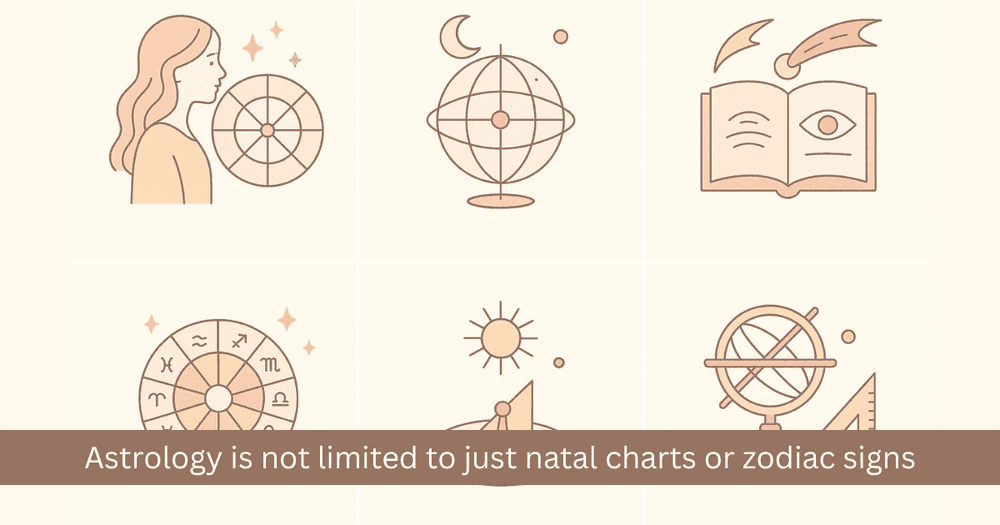The 6 Major Branches of Astrology: Introduction to Jataka, Gola, Nimitta, Prashna, Muhurta and Ganita
By Pt. Abhishek Sharma
An overview of Vedic astrology’s six branches and their practical application

Table of Contents
Astrology is not limited to just natal charts or zodiac signs. It comprises several distinct branches, each based on different objectives and methodologies. Ancient Indian astrology is broadly divided into six principal branches: Jataka (Natal Astrology), Gola (Astronomy and Planetary Positions), Nimitta (Omens), Prashna (Horary Astrology), Muhurta (Electional Astrology) and Ganita (Astronomical Calculations). Together, these branches form a complete and profoundly studied science. This article aims to provide an in-depth explanation of these six branches.
The Three Divisions and Six Branches of Ancient Hindu Astrology: A Detailed Overview
Ancient sages classified Hindu astrology (Jyotish) into different segments to clarify its depth and variety. The renowned astrologer Varahamihira first divided astrology into three main parts: Ganita (Calculations), Hora (Predictive Astrology) and Angavinischaya (Ascendant and House Determinations). In Brihat Samhita (I.9), Varahamihira writes: "Astrology is divided into three principal divisions: Ganita or Tantra, Hora and Angavinischaya. Together, these form the Samhita. The Ganita division concerns calculations based on planetary motions and zodiac signs. The Hora division deals with natal charts and predictions, whereas Angavinischaya explains the calculation methods for the ascendant and house positions." In earlier times, computational aspects were split into two parts-calculating planetary positions was handled under Ganita while ascendant calculations came under Angavinischaya. The sage Garg also divided astrology into three parts, naming the third segment Shakha (branch).
The Classification of Six Branches According to Prashna Marga
In the 17th-century text Prashna Marga (I.5-6), another classification appears wherein astrology is divided into three divisions and six branches: “Ancient astrology is categorized into three divisions and six branches. The divisions are Ganita, Samhita and Hora.” “The sages classified Jyotish into six branches: Jataka, Gola, Nimitta, Prashna, Muhurta and Ganita.” (Prashna Marga, I.6)
Explanation of These Six Branches
- Jataka (Natal Astrology): Astrology based on the birth chart, exploring a person’s life path and future.
- Gola (Astronomy): Geometrical study of celestial objects and planetary positions.
- Ganita (Mathematics): Encompasses all kinds of astronomical calculations.
- Nimitta (Omens): Interpretations based on auspicious and inauspicious signs, natural phenomena, weather and crop forecasts.
- Prashna (Horary Astrology): Predictions based on the time a question is posed, employing a specialized chart and analysis.
- Muhurta (Electional Astrology): Determining the most auspicious timings for important events and activities.
Relationship Between Divisions and Branches
The Sanskrit term Skandha means a broad division or principal branch. In Vedanga Jyotisha or traditional Vedic astrology, Skandha denotes a major category encompassing specific subfields, such as Jataka or Nimitta. The word Anga literally means a component or part. Compared to Skandha, an Anga is a more specific unit or branch representing a distinct technical or practical field within a larger division. For example, Ganita and Hora are Skandhas and within them we find branches like Nimitta and Prashna. In Prashna Marga (I.7), the interrelation is described as follows: “The Ganita division includes the mathematical and Gola branches. The Hora division encompasses horoscopy, Prashna, Muhurta and part of Nimitta. The Samhita division mainly focuses on Nimitta.”
Dual Classification Regarding Evidence and Results
Another verse in the same text introduces a dual classification: “Astrology can be divided into two parts: Pramana (evidence) and Phala (results). Ganita falls under Pramana, while the other two divisions fall under Phala.” (Prashna Marga I.9) This highlights two essential aspects of astrology:
- Pramana: The exact computational and astronomical calculations (Ganita Jyotish).
- Phala: The predictive and interpretative methods (Hora and Samhita Jyotish).
Final Thoughts
This comprehensive classification reveals how ancient scholars structured the vast range of astrological knowledge. Whether focusing on computations or predictive interpretations, these divisions and branches combined to form a scientific, cultural and philosophical system. Rooted in the Vedanga Jyotish tradition, these categories underscore astrology’s profound historical and spiritual significance.
Did you like it?
Author

Pt. Abhishek Sharma (43)
Experience: 19
Consults About: Marriage, Relationships, Career
Clients In: CG, OD, DL, UP, MP
Share this article with friends and family